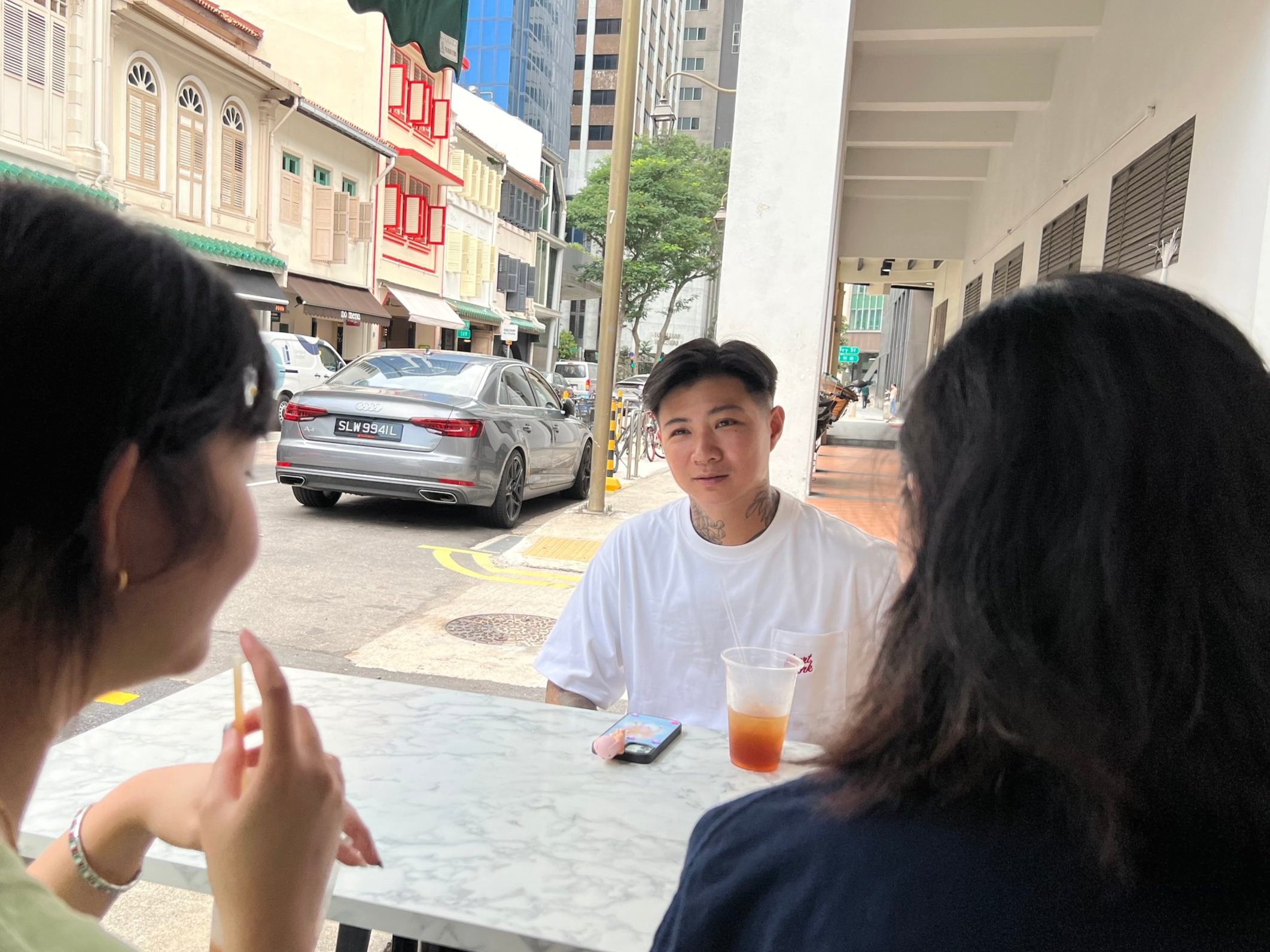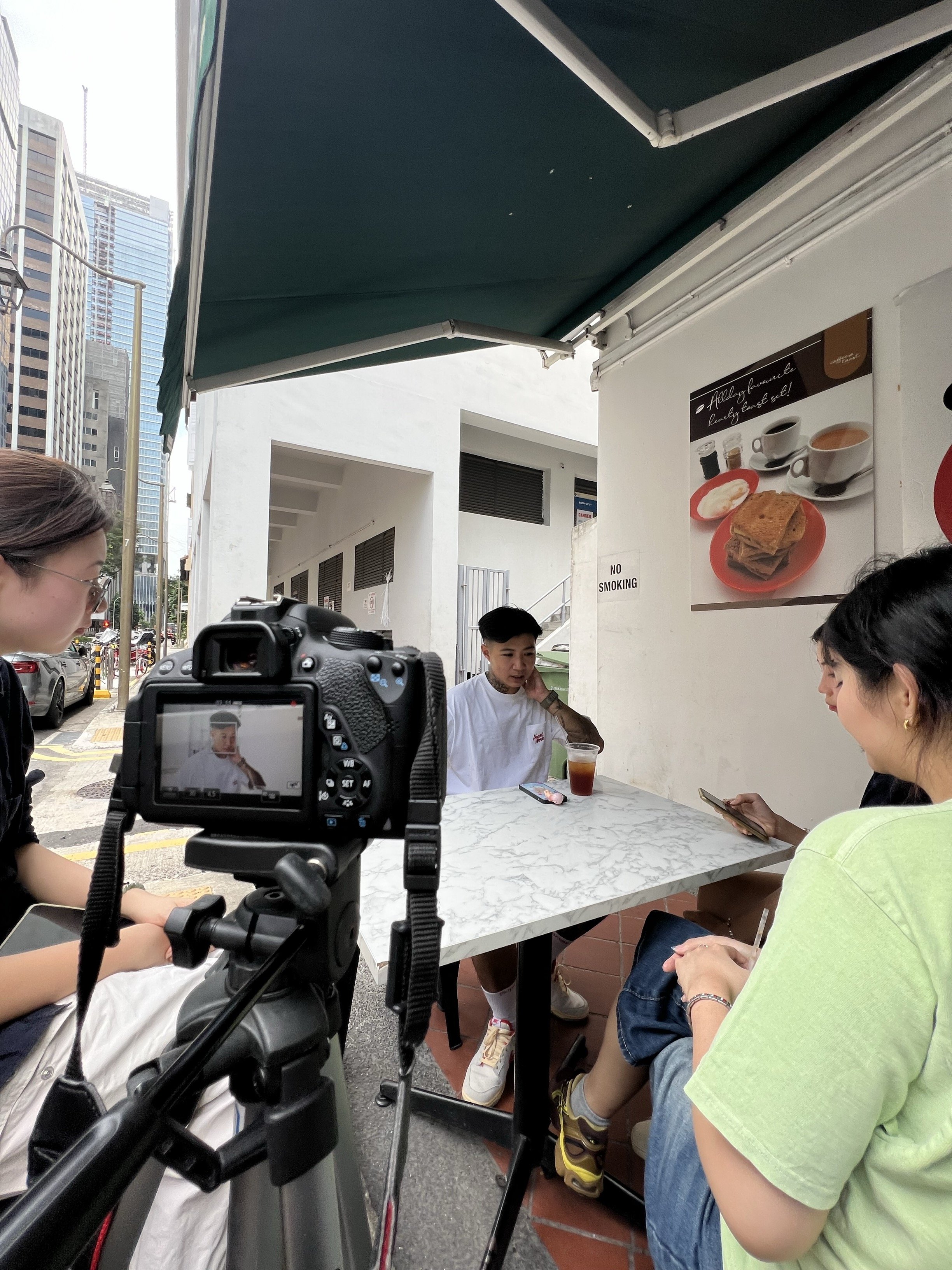


CONTRIBUTORS
- Amethyst Koh Hnin Nu Aye
- Koh Jay Ling Jaclyn
- Norica Binte Taslim
- Renee Yeo Zhi Hui
- Zhang Runhan
- Zhou Yuyan
Sam Lo: Making His Mark
In Singapore’s systemically kept and meticulously maintained streets, public art is an element that is unavoidably bound to her rules. Sculptures, murals, street art—they are allowed to exist only through the green lights of the restrictive government body. And any other form of public art that slips through the cracks—appearing overnight on the stairwell or void deck of a HDB—sparks controversy in the public eye with questions of vandalism 1, regarded by many as weed that needs to be pulled.
In 2011, stickers pasted on traffic light buttons began to appear around the city, with quirky Singaporean expressions such as “Press Once Can Already” and “Anyhow Press Police Catch,” going viral quickly as people began to share them online, pushing Sam Lo into the public consciousness. The phrase “My Grandfather Road”—a phrase used by Singaporeans to criticize or scold others when they are in the way of others—also appeared, spray-stenciled along roads in the central business district. Following his acts of ‘vandalizing’ public property, Sam was charged with, and pleaded guilty to, mischief. To him, it was a way to reclaim public spaces in Singapore as a demonstration of the Singaporean “soul and character.” 2 This was the beginning of his career as an artist. Sam expresses that he has never regretted his run in with the law when asked how he went about the restrictions. He replied with, “it wouldn’t really feel like (there's) anything to be (restricted by)” given that he knew what he was getting himself into when he decided to paste the stickers on illegally. 3 He had a motivation and a statement to make that is not to be limited by government censorship and restrictions.
Following then, the stickers have since been removed, the paint washed off, restoring the roads back to their former clean, unblemished state.
Sam began to venture into graffiti, and mural art, stating that he wanted to prove to himself that he could do more, pushing himself further each time—from beginning to learn spray painting, to exploring colors over time. From black and white to adding on reds, his murals have gotten more colorful, now consisting of a myriad of colors that decorate the walls he paints. The first pride mural that is situated at Aliwal Arts Center was the start of his pride mural walls, and it is especially significant given the restrictions and censorship surrounding public art in Singapore. He chooses to take up that challenge as an opportunity to bring light and representation to the queer community, with hopes that he can also make this an annual event to help support queer initiatives, saying: “If none of us is going to do it, then who’s going to do it?” The beauty of painting murals, Sam explains, is seeing and hearing people’s reactions and knowing that you’re contributing to their community and the environment that they live in, making the experience more meaningful. The sense of community and moments of encouragement are what spurs him on to keep going on as a public artist. 4
The quality of ‘transience’ is profoundly felt in Sam Lo’s works, many of which are impermanent due to nature. Graffiti, street art, murals are painted over and painted on, existing in only that specific space and time before it is eventually replaced, washed over with another layer of paint. The ephemeral and transient quality of these works is something so inherently conflicting with the art world’s pursuit of preserving art, of documenting and archiving art; how do we hold on to art that was never made to last?
When asked about the concept of ‘permanence’ in a medium like graffiti art that often faces erasure, Sam’s response is, “(he has) already accepted that it isn’t (permanent)” and can only do his best to document it. In the age of digital permanence, “once on the internet, always on the internet,” everything is documented and online. A search on the internet can lead you to countless photos and videos of his works—Stickers, My Grandfather Road, LIMPEH. What, however, cannot be captured is art that exists in a particular time and space, the experience of seeing the work as it is during that moment cannot be replaced by a replica that exists in the digital space or on a poster. The impact and experience of the audience looking at the writing on the road for ‘My Grandfather Road’ would definitely be different from viewing the photo recordings online. The works do not simply exist in a void alone, the cityscape it exists in, as well as the environment, all contribute to the overall presentation of the work, giving it context and meaning. And these are the elements that cannot be documented through photographs.
We believe, however, that that is part of the beauty of street art— it is in the moment, transient and ephemeral, but real and raw. There is no filtering or sanitization of the message portrayed; it is purely what the artist feels, what the artist has to say and what the artist wants to show, that is seen by the people in that moment. In Sam’s words: “I know that what I stood for and what I stand for now is the same— my work has always been for people and inspired (by) people.”
References:1 Sin, Y. (2018, September 11) Parliament: Set up independent body to look into disputes over art in public spaces, says Arts NMP. Retrieved from https://www.straitstimes.com/politics/set-up-independent-body-to-look-into-disputes-over-art-in-public-spaces-arts-nmp
2 Hashimi, H. N. (2023, July 3) Artist Sam Lo reflects on identity, art and pride 10 years after his brush with the law. Retrieved from https://www.tatlerasia.com/lifestyle/arts/visual-artist-sam-lo-social-commentary-singapore-interview
3 Koh, A., Koh, J., Taslim, N., Yeo, R., Zhang, R., Zhou, Y. (2023, October 13). Interview with Sam Lo. personal.
4 Koh, A., Koh, J., Taslim, N., Yeo, R., Zhang, R., Zhou, Y. (2023, October 13). Interview with Sam Lo. personal.
